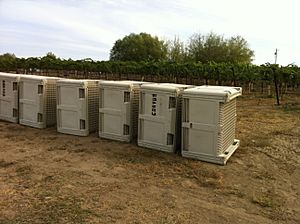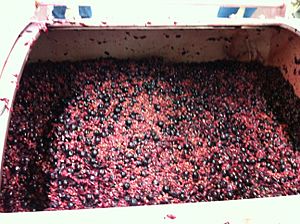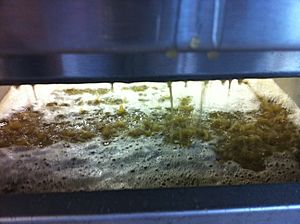Yield (wine) facts for kids
In viticulture, yield is a way to measure how many grapes or how much wine is made from a certain area of a vineyard. Think of it like how much fruit a farmer gets from their field. It's a type of crop yield. We usually measure yield in two ways: by the weight of grapes from a vineyard area, or by the amount of wine produced from that same area.
Many people believe that lower yields lead to better, more flavorful wines. Because of this, many wine regions have rules about the maximum yield allowed for their wines.
Contents
How Do We Measure Wine Yield?
In most parts of Europe, people measure wine yield in hectoliters per hectare. A hectoliter is 100 liters, and a hectare is a unit of land area (about 2.5 acres). So, it's about the volume of wine made from a certain land size.
In many New World countries, like the USA, yield is measured by the weight of grapes. They use tons per hectare (or short tons per acre in the USA). This means they measure how much grape mass is produced from a certain land area.
It's tricky to convert exactly between these two ways of measuring. This is because different types of grapes and different winemaking methods produce different amounts of wine from the same weight of grapes. For example, you need more grapes to make 100 liters of white wine (around 160 kg) than red wine (around 130 kg).
Typical Wine Yields Around the World
The amount of wine produced can change a lot depending on the country, region, and even the specific vineyard. It can also vary from year to year because of weather conditions. A common yield for many places is around 50 hectoliters per hectare, which is about 3 tons of grapes per acre.
Here's a look at average yields in some wine-producing countries in 2007:
| Country | Average Yield (hectoliters per hectare) |
|---|---|
| Italy | 55 |
| France | 52 |
| Spain | 30 |
| United States | 49 |
| Argentina | 65 |
| Germany | 103 |
| South Africa | 73 |
| Australia | 55 |
| Portugal | 23 |
| Austria | 52 |
Does Yield Affect Wine Quality?
Many people in the wine world believe that yield is very important for wine quality. If a vine produces too many grape clusters, the grapes might not ripen well. This can lead to a poor-quality wine because the vine's leaves can't provide enough energy for all the fruit. This usually happens with very high yields, like 200 hectoliters per hectare or more.
However, there are different ideas about how low the yield needs to be for great wine. Some believe that excellent red wine can't be made if the yield is more than 50 hectoliters per hectare. Others think that even 100 hectoliters per hectare can produce high-quality wine if the vineyard is managed very carefully. White wines are generally thought to be less affected by higher yields than red wines. Some grape varieties, like Pinot noir, are known to be very sensitive to producing too many grapes.
Sometimes, a low yield in a particular year might actually mean lower quality. This can happen if the low yield is due to bad weather like hail or diseases like grey rot, which damage the grapes. For example, in the 1980s, some of the best Bordeaux vintages (years) were actually the ones with the most abundant harvests.
Rules About Wine Yields
In countries like France and Italy, there are specific wine laws that set the maximum allowed yields. These rules can be different for each wine region or "appellation."
In France, the maximum yields are part of the rules for each appellation d'origine contrôlée (AOC). An AOC is a protected name that guarantees the quality and origin of a wine. The maximum yield for an AOC in a certain year is a combination of a basic yield and a special percentage that can change each year. This percentage often allows for about 20% more production than the basic yield.
Images for kids
See also
 In Spanish: Rendimiento (viticultura) para niños
In Spanish: Rendimiento (viticultura) para niños








